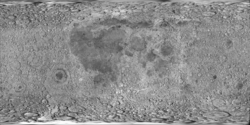Snellius és un cràter d'impacte lunar a prop de l'extremitat sud de la Lluna. A causa de la seva posició sembla que tingui forma oval des de la Terra, encara que en realitat és gairebé rodó. Al nord hi ha el gran cràter Petavius. Al sud de Snellius és el Stevinus cràter. La vora del Snellius està molt desgastada i erosionada, amb cràters superposats. El sòl és una mica irregular i desigual. La vora occidental marca l'inici de la Valles Snellius, una de les valls més llargs a la Lluna. Segueix prop de 500 quilòmetres al nord-oest de prop de la riba del Mare Nectaris. El seu origen és més probable associat amb la formació del mar lunar. Just al nord-oest hi ha Snellius A, un cràter amb una estructura de raigs notable que se superposa al sud-oest sobre la Mare Fecunditatis al nord.
Vegeu també
Bibliografia
- (WGPSN), IAU Working Group for Planetary System Nomenclature. «Gazetteer of Planetary Nomenclature. 1:1 Million-Scale Maps of the Moon» (en anglès). UAI / USGS, 13-02-2013. [Consulta: 6 abril 2016].
- Andersson, L. E.; Whitaker, E. A.,. NASA Catalogue of Lunar Nomenclature (en anglès). NASA RP-1097, 1982.
- Blue, Jennifer. «Gazetteer of Planetary Nomenclature» (en anglès). USGS, 25-07-2007. [Consulta: 2 gener 2012].
- Bussey, B.; Spudis, P.. The Clementine Atlas of the Moon (en anglès). Nueva York: Cambridge University Press, 2004. ISBN 0-521-81528-2.
- Cocks, Elijah E.; Cocks, Josiah C.. Who's Who on the Moon: A Biographical Dictionary of Lunar Nomenclature (en anglès). Tudor Publishers, 1995. ISBN 0-936389-27-3.
- McDowell, Jonathan. «Lunar Nomenclature» (en anglès). Jonathan's Space Report, 15-07-2007. [Consulta: 2 gener 2012].
- Menzel, D. H.; Minnaert, M.; Levin, B.; Dollfus, A.; Bell, B. «Report on Lunar Nomenclature by The Working Group of Commission 17 of the IAU» (en anglès). Space Science Reviews, 12, 1971, pàg. 136.
- Moore, Patrick. On the Moon (en anglès). Sterling Publishing Co, 2001. ISBN 0-304-35469-4.
- Price, Fred W. The Moon Observer's Handbook (en anglès). Cambridge University Press, 1988. ISBN 0521335000.
- Rükl, Antonín. Atlas of the Moon (en anglès). Kalmbach Books, 1990. ISBN 0-913135-17-8.
- Webb, Rev. T. W.. Celestial Objects for Common Telescopes, 6ª edición revisada (en anglès). Dover, 1962. ISBN 0-486-20917-2.
- Whitaker, Ewen A. Mapping and Naming the Moon (en anglès). Cambridge University Press, 2003. 978-0-521-54414-6.
- Wlasuk, Peter T. Observing the Moon (en anglès). Springer, 2000. ISBN 1-85233-193-3.
- «A Portfolio of Lunar Drawings» p. 157..(anglès)
- «Gazetteer of Planetary Nomenclature - Moon Nomenclature Table Of Contents». U.S. Geological Survey. (anglès)
- «Atlas of the lunar terminator» p. 136. (anglès)
- «The moon and how to observe it» p. 194. (anglès)
- «Localisation précise et photo du site». desenvolupat per Google Earth, NASA World Wind, Celestia i Stellarium. (anglès)
- «Lunar Atlas». The Lunar Prospector Website. NASA Ames Research Center. Arxivat de l'original el 2007-05-02. [Consulta: 15 maig 2013]. (anglès)
- «Moteur de recherche de l'Institut Lunaire et Planétaire». Universities Space Research Association.[Enllaç no actiu](anglès)

 Snellius
Snellius









